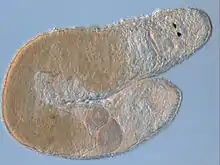Dolichomacrostomidae
The Dolichomacrostomidae[1] are a family of small basal free-living flatworms (Macrostomida, Turbellaria, Platyhelminthes), and members of the marine, but also brackish, meiobenthos.[1] The name was coined by Reinhard M. Rieger (1971), who designated the Dolichomacrostomidae as a family within the taxon Macrostomida.[1] There are currently about 40 named species in this family.[2]
| Dolichomacrostomidae | |
|---|---|
 | |
| An adult Dolichomacrostomum uniporum, a member of the Dolichomacrostominae | |
| Scientific classification | |
| Kingdom: | Animalia |
| Phylum: | Platyhelminthes |
| Class: | Rhabditophora |
| Order: | Macrostomida |
| Family: | Dolichomacrostomidae |
| Subtaxa | |
|
Bathymacrostominae | |
Ecology and distribution
The Dolichomacrostomidae are all members of the meiobenthos. Moreover, they are primarily marine, with some forms entering brackish habitats. Many forms are particularly abundant in the subtidal meiobenthos, but here are also intertidal and a few deep-sea forms. Dolichomacrostomidae can be found in all major oceans worldwide, but many areas have been very poorly studied to date.
Reproduction
Like almost all Platyhelminthes the Dolichomacrostomidae are simultaneous hermaphrodites. They are remarkable for the high complexity of their genitalia. The male copulatory organ often consists of two parts, a glandular and a penis stylet. The former only transfers glandular secretions and the latter both sperm and glandular products. The female genitalia are often associated with sclerotized valve structures of unknown function.[1]
References
- Rieger, R. M. 1971. Die Turbellarienfamilie Dolichomacrostomidae Rieger: II. Teil. Dolichomacrostominae 1. Zool. Jb. Syst. 98:598-703.
- Tyler, S., Schilling, S., Hooge, M., and Bush L. F. (comp.) (2006-2009) Turbellarian taxonomic database. Version 1.5 "Archived copy". Archived from the original on 2011-07-20. Retrieved 2010-02-28.CS1 maint: archived copy as title (link)
External links
- urbellarian Taxonomic Database: A listing of the taxonomy of turbellarians
- Taxonomy and Phylogeny EDIT Scratchpad